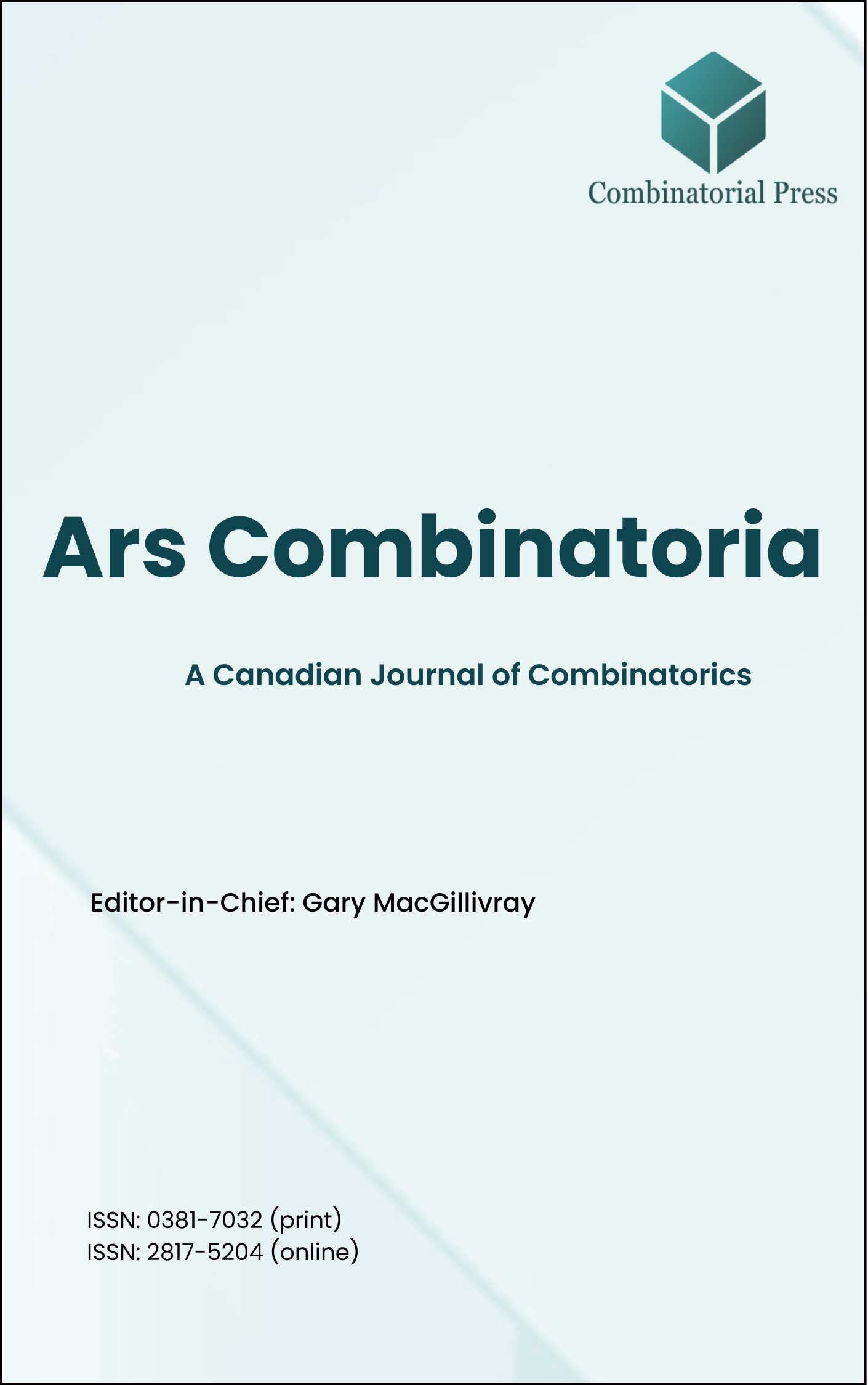
Ars Combinatoria
ISSN 0381-7032 (print), 2817-5204 (online)
Ars Combinatoria is the oldest Canadian Journal of Combinatorics, established in 1976. The journal is dedicated to advancing the field of combinatorial mathematics through the publication of high-quality research papers. From 2024 onward, it publishes four volumes per year in March, June, September and December. Ars Combinatoria has gained recognition and visibility in the academic community and is indexed in renowned databases such as MathSciNet, Zentralblatt, and Scopus. The Scope of the journal includes Graph theory, Design theory, Extremal combinatorics, Enumeration, Algebraic combinatorics, Combinatorial optimization, Ramsey theory, Automorphism groups, Coding theory, Finite geometries, Chemical graph theory but not limited.
Information Menu
- Research article
- Full Text
- Ars Combinatoria
- Volume 038
- Pages: 129-136
- Published: 31/12/1994
A correspondence between decompositions of complete directed graphs with loops into collections of closed trails which partition the edge set of the graph and the variety of all column latin groupoids is established. Subvarieties which consist of column latin groupoids arising from decompositions where only certain trail lengths occur are examined. For all positive integers \(m\), the set of values of \(n\) for which the complete directed graph with loops on a vertex set of cardinality \(n\) can be decomposed in this manner such that all the closed trails have length \(m\) is shown to be the set of all \(n\) for which \(m\) divides \(n^2\).
- Research article
- Full Text
- Ars Combinatoria
- Volume 038
- Pages: 119-128
- Published: 31/12/1994
Let \(X\) be a graph and let \(\alpha(X)\) and \(\alpha'(X)\) denote the domination number and independent domination number of \(X\), respectively. We show that for every triple \((m,k,n)\), \(m \geq 5\), \(2 \leq k \leq m\), \(n > 1\), there exist \(m\)-regular \(k\)-connected graphs \(X\) with \(\alpha'(X) – \alpha(X) > n\). The same also holds for \(m = 4\) and \(k \in \{2,4\}\).
- Research article
- Full Text
- Ars Combinatoria
- Volume 038
- Pages: 113-117
- Published: 31/12/1994
Let \(k\) be an integer greater than one. A set \(S\) of integers is called \(k\)-multiple-free (or \(k\)-MF for short) if \(x \in S\) implies \(kx \notin S\). Let \(f_k(n) = \max\{|A| : A \subseteq [1,n] \text{ is } k\text{-MF}\}\). A subset \(A\) of \([1,n]\) with \(|A| = f_k(n)\) is called a maximal \(k\)-MF subset of \([1,n]\). In this paper, we give a recurrence relation and a formula for \(f_k(n)\). In addition, we give a method for constructing a maximal \(k\)-MF subset of \([1,n]\).
- Research article
- Full Text
- Ars Combinatoria
- Volume 038
- Pages: 97-111
- Published: 31/12/1994
This paper concerns the domination numbers \(\gamma_{k,n}\) for the complete \(k \times n\) grid graphs for \(1 \leq k \leq 10\) and \(n \geq 1\). These numbers were previously established for \(1 \leq k \leq 4\). Here we present dominating sets for \(5 \leq k \leq 10\) and \(n \geq 1\). This gives upper bounds for \(\gamma_{k,n}\) for \(k\) in this range. We discuss evidence that indicates that these upper bounds are also lower bounds.
- Research article
- Full Text
- Ars Combinatoria
- Volume 038
- Pages: 87-95
- Published: 31/12/1994
By a graph we mean an undirected simple graph. The genus \(\gamma(G)\) of a graph \(G\) is the minimum genus of the orientable surface on which \(G\) is embeddable. The thickness \(\Theta(G)\) of \(G\) is the minimum number of planar subgraphs whose union is \(G\).
In [1], it is proved that, if \(\gamma(G) = 1\), then \(\Theta(G) = 2\). If \(\gamma(G) = 2\), the known best upper bound on \(\Theta(G)\) is \(4\) and, as far as the author knows, the known best lower bound is \(2\). In this paper, we prove that, if \(\gamma(G) = 2\), then \(\Theta(G) \leq 3\).
- Research article
- Full Text
- Ars Combinatoria
- Volume 038
- Pages: 77-86
- Published: 31/12/1994
A generalization of (binary) balanced incomplete block designs is to allow a treatment to occur in a block more than once, that is, instead of having blocks of the design as sets, allow multisets as blocks. Such a generalization is referred to as an \(n\)-ary design. There are at least three such generalizations studied in the literature. The present note studies the relationship between these three definitions. We also give some results for the special case when \(n\) is \(3\).
- Research article
- Full Text
- Ars Combinatoria
- Volume 038
- Pages: 65-76
- Published: 31/12/1994
We investigate searching strategies for the set \(\{1, \ldots, n\}\) assuming a fixed bound on the number of erroneous answers and forbidding repetition of questions. This setting models the situation when different processors provide answers to different tests and at most \(k\) processors are faulty. We show for what values of \(k\) the search is feasible and provide optimal testing strategies if at most one unit is faulty.
- Research article
- Full Text
- Ars Combinatoria
- Volume 038
- Pages: 57-63
- Published: 31/12/1994
Ramsey’s Theorem implies that for any graph \(H\) there is a least integer \(r = r(H)\) such that if \(G\) is any graph of order at least \(r\) then either \(G\) or its complement contains \(H\) as a subgraph. For \(n<r\) and \(0 \leq e \leq \frac{1}{2}n(n-1)\), let \(f(e) =1\) {if every graph \(G\) of order \(n\) and size \(e\) is such that either \(G\) or \(\overline{G}\) contains \(H\),} and let \(f(e)=0\) {otherwise.} This associates with the pair \((H,n)\) a binary sequence \(S(H,n)\). By an interval of \(S(H,n)\) we mean a maximal string of equal terms. We show that there exist infinitely many pairs \((H,n)\) for which \(S(H,n)\) has seven intervals.
- Research article
- Full Text
- Ars Combinatoria
- Volume 038
- Pages: 47-55
- Published: 31/12/1994
In this paper the existence of the \(12140\) non-isomorphic symmetric \((49,16,5)\) designs with an involutory homology (this is a special kind of involution acting on a design) is propagated. The automorphism groups are cyclic of orders \(2\), \(4\), \(8\), or \(10\). \(218\) designs are self-dual. The \(40\) designs with an automorphism group of order \(10\) were already given in [2]. A computer (IBM \(3090\)) was used for about \(36\) hours CPU time. According to [2,4] now there are known \(12146\) symmetric \((49,16,5)\) designs.
- Research article
- Full Text
- Ars Combinatoria
- Volume 038
- Pages: 33-45
- Published: 31/12/1994
This paper deals with the joint distributions of some characteristics of the two-dimensional simple symmetric random walk in which a particle at any stage moves one unit in any one of the four directions, namely, north, south, east, and west with equal probability.





